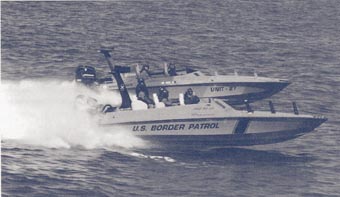
|
Novel
High-Speed Boat Aids Military and Law Enforcement If you happened to be gazing at Boston Harbor from a warm office building one afternoon in early February, you might have wondered why a Nigerian Navy speedboat was zipping across the white caps at close to 70 mph, whipping into hairpin turns that should have made the boat flip over (and over and over). The 27-foot twin-hull craft, designed and built by Marshfield, Mass.--based Intercept Boats, is indeed bound for Nigeria--hence the bright yellow lettering. But on this day, the boat, known as a Night Cat 27, was providing the Massachusetts State Police with a taste of what they too would soon be captaining. Intercept's owner, Bob Perette, says he
got the idea for designing a high-speed boat for military and law enforcement agencies in the early 1990s while reading a magazine article about how the United States was losing the war on drugs because those with drugs had faster boats. "So I started doing some testing in my bathtub with these little models," says Perette, who was then working in the automotive industry and had no experience as a boat builder. Perette brought one of those models to Cliff Goudey at MIT Sea Grant, hoping he would test it and thereby provide the quantifiable data needed to convince others that the craft was not your average cigarette boat. Goudey, the director of MITSG's Center for Fisheries Engineering Research (CFER), suggested that Perette go one step farther and incorporate modifications to a boat Perette already ownedóand then he could test the boat in a real-life scenario. For that, Goudey and Justin Manley, then a student in MIT's Undergraduate Research Opportunity Program (UROP), created an instrumentation unit óbasically a black box with a motion sensing packageówhich they connected to a laptop computer. "We took the unit out on Bob's boat and then on a similar sized conventional deep-V hull," says Goudey. "We were measuring accelerations and rotation rates in three axes. Measuring these six degrees of freedom, we were able to compare the performance of the two boats on that choppy day off Hull, Massachusetts." He recalls that the pitch and heave in particular were noticeably less with Perette's novel design, and the boat tracked as if it were on rails, making high-speed turns that he did not think were possible. The CFER report that resulted from the experiments quantified the substantial improvements. The data piqued the interest of the Naval Surface Warfare Center in Suffolk, VA. "The Navy then tested the boat, and the results were the same," says Perette, who points out that the smooth ride translates into an advantage in terms of less fatigue. Anybody who has spent time bumping up and down in a speedboat knows that the motion quickly becomes exhausting. And that fatigue is a critical concern for military and law enforcement personnel. According to the Navy's findings, the Night Cat's ride was roughly 300 percent less fatiguing than the speedboat against which it was tested. This means that a person riding in the Night Cat for nearly five hours in four-foot seas would be as tired as a person riding for 1.5 hours in another boat. The boat's unique hull design also allows it to turn at a rate of 41 degrees per second‚or 112 percent faster than similar craft. The 27-foot catamaran, powered by two 300-horsepower outboards, is constructed of foamcore covered with fiberglass. The front end of the boat is reinforced (for ramming other boats) and four padeyes at the corners mean that the boat can be picked up by a helicopter. With a fuel tank that holds 210 gallons, the Night Cat can operate for roughly eight hours and reach speeds of 70 mph. "I'm a sailor and not particularly fond of high-speed powerboats, but I've never been on a boat that can do the kinds of things this one can," says Goudey. He also notes that it's not exactly clear which design features are responsible for this superior performance. "I think Perette simply hit on a combination of changes that makes it work." Perette sees the boat as the wave of the future for law enforcement and notes, not surprisingly, that the Night Cat has gotten a lot more attention since 9/11. Shortly thereafter, the Boston Police Department sought his help in guiding a liquefied natural gas (LNG) tanker into Boston Harbor with a SWAT team. "My boat was the only boat in the neighborhood that was highly maneuverable, and at the time we had painted it with an anti-reflective coating to make it hard to see," he explains. Perette began preparations but ended up not participating in the actual mission, he says, after Boston Mayor Thomas Menino got a court injunction to temporarily keep the LNG tankers out of the harbor. Thus far, Intercept has delivered one boat to the U.S. Border Patrol in Miami, and another to the Nigerian Navy, which has ordered three more to protect oil platforms and perform Coast Guard duties. The company is now building two boats for the Boston Police Department. The price tag for each is approximately $250,000 and includes training for personnel who will be using the boats. Lt. Aldo D'Angelo, commander of the Massachusetts State Police Marine Section, says that, among other tasks, his agency's two new Night Cats will be escorting LNG tankers into Boston Harbor "This will give us the capacity to intercept particular threats," he says, adding that "95 percent of our fleet is over 25 years old." As a small company employing just three full-time employees, Intercept's current success, notes Goudey, is a testament to dogged marketing and Perette's faith in his product. "He's faced a long, hard road," says Goudey. "It's satisfying to know that our tests played a pivotal role in getting the attention of federal agencies, and getting these boats where they're needed." |
